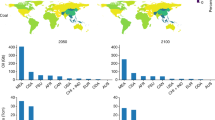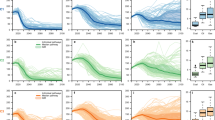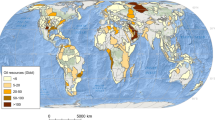Abstract
Policy makers have generally agreed that the average global temperature rise caused by greenhouse gas emissions should not exceed 2 °C above the average global temperature of pre-industrial times1. It has been estimated that to have at least a 50 per cent chance of keeping warming below 2 °C throughout the twenty-first century, the cumulative carbon emissions between 2011 and 2050 need to be limited to around 1,100 gigatonnes of carbon dioxide (Gt CO2)2,3. However, the greenhouse gas emissions contained in present estimates of global fossil fuel reserves are around three times higher than this2,4, and so the unabated use of all current fossil fuel reserves is incompatible with a warming limit of 2 °C. Here we use a single integrated assessment model that contains estimates of the quantities, locations and nature of the world’s oil, gas and coal reserves and resources, and which is shown to be consistent with a wide variety of modelling approaches with different assumptions5, to explore the implications of this emissions limit for fossil fuel production in different regions. Our results suggest that, globally, a third of oil reserves, half of gas reserves and over 80 per cent of current coal reserves should remain unused from 2010 to 2050 in order to meet the target of 2 °C. We show that development of resources in the Arctic and any increase in unconventional oil production are incommensurate with efforts to limit average global warming to 2 °C. Our results show that policy makers’ instincts to exploit rapidly and completely their territorial fossil fuels are, in aggregate, inconsistent with their commitments to this temperature limit. Implementation of this policy commitment would also render unnecessary continued substantial expenditure on fossil fuel exploration, because any new discoveries could not lead to increased aggregate production.
This is a preview of subscription content, access via your institution
Access options
Subscribe to this journal
Receive 51 print issues and online access
$199.00 per year
only $3.90 per issue
Buy this article
- Purchase on Springer Link
- Instant access to full article PDF
Prices may be subject to local taxes which are calculated during checkout



Similar content being viewed by others
References
United Nations Framework Convention on Climate Change (UNFCC) Report of the Conference of the Parties on its Fifteenth Session, held in Copenhagen from 7 to 19 December 2009. Part Two: Action taken by the Conference of the Parties at its Fifteenth Session. United Nations Climate Change Conf. Report 43 http://unfccc.int/resource/docs/2009/cop15/eng/11a01.pdf (UNFCC, 2009)
Meinshausen, M. et al. Greenhouse gas emission targets for limiting global warming to 2 °C. Nature 458, 1158–1162 (2009)
Clarke, L. et al. in Climate Change 2014: Mitigation of Climate Change ( Edenhofer, O. et al.) Ch. 6 (Cambridge Univ. Press, 2014)
Raupach, M. R. et al. Sharing a quota on cumulative carbon emissions. Nature Clim. Chang. 4, 873–879 (2014)
IPCC Working Group III. Integrated Assessment Modelling Consortium (IAMC) AR5 Scenario Databasehttps://secure.iiasa.ac.at/web-apps/ene/AR5DB/ (International Institute for Applied Systems Analysis 2014).
Allen, M. R. et al. Warming caused by cumulative carbon emissions towards the trillionth tonne. Nature 458, 1163–1166 (2009)
Matthews, H. D., Gillett, N. P., Stott, P. A. & Zickfeld, K. The proportionality of global warming to cumulative carbon emissions. Nature 459, 829–832 (2009)
Friedlingstein, P. et al. Persistent growth of CO2 emissions and implications for reaching climate targets. Nature Geosci. 7, 709–715 (2014)
Leaton, J. Unburnable Carbon—Are the World’s Financial Markets Carrying a Carbon Bubble? http://www.carbontracker.org/wp-content/uploads/2014/09/Unburnable-Carbon-Full-rev2-1.pdf (Investor Watch, 2011)
McGlade, C. E. A review of the uncertainties in estimates of global oil resources. Energy 47, 262–270 (2012)
Society of Petroleum Engineers (SPE). Petroleum Resources Management System.www.spe.org/industry/docs/Petroleum_Resources_Management_System_2007.pdf (SPE, 2008)
Bauer, N. et al. Global fossil energy markets and climate change mitigation—an analysis with REMIND. Clim. Change http://dx.doi.org/10.1007/s10584-013-0901-6 (2013)
Anandarajah, G., Pye, S., Usher, W., Kesicki, F. & McGlade, C. E. TIAM-UCL Global Model Documentation. http://www.ucl.ac.uk/energy-models/models/tiam-ucl/tiam-ucl-manual (University College London, 2011)
Meinshausen, M., Raper, S. C. B. & Wigley, T. M. L. Emulating atmosphere–ocean and carbon cycle models with a simpler model, MAGICC6—Part 1: Model description and calibration. Atmos. Chem. Phys. 11, 1417–1456 (2011)
Usher, W. & Strachan, N. Critical mid-term uncertainties in long-term decarbonisation pathways. Energy Policy 41, 433–444 (2012)
IEA. Resources to Reserves Ch. 8 (International Energy Agency, 2013)
Alberta Energy Regulator (AER). Alberta’s Energy Reserves 2013 and Supply/Demand Outlook 2014–2023.http://www.aer.ca/documents/sts/ST98/ST98-2014.pdf (AER, 2014)
Yergin, D. The Prize: the Epic Quest for Oil, Money and Power Epilogue (Simon and Schuster, 2009)
McKelvey, V. E. Mineral resource estimates and public policy. Am. Sci. 60, 32–40 (1972)
McGlade, C. E., Speirs, J. & Sorrell, S. Unconventional gas—a review of regional and global resource estimates. Energy 55, 571–584 (2013)
Federal Institute for Geosciences and Natural Resources (BGR). Energy Study 2012. Reserves, Resources and Availability of Energy Resources.http://www.bgr.bund.de/DE/Gemeinsames/Produkte/Downloads/DERA_Rohstoffinformationen/rohstoffinformationen-15e.pdf?__blob=publicationFile&v=3 (BGR, 2012)
McGlade, C. E. Uncertainties in the outlook for oil and gas. PhD thesis, UCL, http://discovery.ucl.ac.uk/1418473/2/131106%20Christophe%20McGlade_PhD%20Thesis.pdf (2013)
Klett, T. & Schmoker, J. in Giant Oil and Gas fields of the Decade 1990–1999 (ed. Halbouty, M. T. ) 107–122 (The American Association of Petroleum Geologists, 2003)
Attanasi, E. D. & Freeman, P. A. Survey of Stranded Gas and Delivered Costs to Europe of Selected Gas Resources. SPE Econ. Manag. 3, 149–162 (2011)
International Energy Agency (IEA). World Energy Outlook.http://www.worldenergyoutlook.org/media/weowebsite/2008-1994/weo2008.pdf (IEA, 2008)
Trinnaman, J. & Clarke, A. Survey of Energy Resources http://www.worldenergy.org/wp-content/uploads/2012/09/ser_2010_report_1.pdf (World Energy Council, 2010)
International Energy Agency (IEA). World Energy Outlook. http://www.worldenergyoutlook.org/publications/weo-2013/ (IEA, 2013)
International Energy Agency (IEA). World Energy Outlook. http://www.iea.org/publications/freepublications/publication/weo2011_web.pdf (IEA, 2011)
Rogner, H.-H. et al. in Global Energy Assessment—Towards a Sustainable Future Ch. 7 423–512 (Cambridge University Press, 2012)
Owen, N. A., Inderwildi, O. R. & King, D. A. The status of conventional world oil reserves—hype or cause for concern? Energy Policy 38, 4743–4749 (2010)
McGlade, C. & Ekins, P. Un-burnable oil: an examination of oil resource utilisation in a decarbonised energy system. Energy Policy 64, 102–112 (2014)
International Energy Agency (IEA). World Energy Outlook. http://www.worldenergyoutlook.org/media/weowebsite/2009/WEO2009.pdf (IEA, 2009)
Leatherdale, A. et al. Bioenergy Review: Technical Paper 2—Global and UK Bioenergy Supply Scenarios.http://archive.theccc.org.uk/aws2/Bioenergy/1463%20CCC_Bio-TP2_supply-scen_FINALwithBkMks.pdf (Committee on Climate Change, 2011)
O’Neill, B. C. et al. A new scenario framework for climate change research: the concept of shared socioeconomic pathways. Clim. Change 122, 387–400 (2014)
Campbell, C. J. Atlas of Oil and Gas Depletion (Springer, 2013)
Herrmann, L. et al. Oil and Gas for Beginners 270–413 (Deutsche Bank, 2013)
Klett, T. R. et al. An Assessment of Potential Additions to Conventional Oil and Gas Resources of the World (outside the United States) from Reserve Growth. http://pubs.usgs.gov/fs/2012/3052/fs2012-3052.pdf (USGS, 2012)
Klett, T. R. et al. Potential Additions to Conventional Oil and Gas Resources in Discovered Fields of the United States from Reserve Growth, 2012. http://pubs.usgs.gov/fs/2012/3108/ (USGS, 2012)
Ahlbrandt, T., Charpentier, R., Klett, T., Schmoker, J. & Schenk, C. USGS World Petroleum Assessment 2000. http://pubs.usgs.gov/dds/dds-060/ (USGS, 2000)
Bentley, R., Miller, R., Wheeler, S. & Boyle, G. UKERC Review of Evidence on Global Oil Depletion: Annex 1—Models of global oil supply for the period 2008-2030. http://www.ukerc.ac.uk/support/tiki-download_file.php?fileId=292 (UKERC, 2009)
Brownfield, M., Charpentier, R. R., Cook, T., Gautier, D. L. & Higley, D. K. An Estimate of Undiscovered Conventional Oil and Gas Resources of the World, 2012. http://pubs.usgs.gov/fs/2012/3042/fs2012-3042.pdf (USGS, 2012)
Gautier, D. L. et al. Assessment of undiscovered oil and gas in the Arctic. Science 324, 1175–1179 (2009)
Smith, T. Arctic dreams—a reality check. Geo ExPro. 4, 16–24 (2007)
Shah, A. et al. A review of novel techniques for heavy oil and bitumen extraction and upgrading. Energy Environ. Sci. 3, 700–714 (2010)
Clarke, B. NPC Global Oil and Gas Study: Topic Paper 22—Heavy Oil. http://www.npc.org/study_topic_papers/22-ttg-heavy-oil.pdf (National Petroleum Council, 2007)
Schenk, C. et al. An Estimate of Recoverable Heavy Oil Resources of the Orinoco Oil Belt, Venezuela.http://pubs.usgs.gov/fs/2009/3028/pdf/FS09-3028.pdf (USGS, 2009)
Attanasi, E. D. & Meyer, R. F. in 2010 Survey of Energy Resources 123–150 (World Energy Council, 2010)
Johnson, R. C., Mercier, T. J. & Brownfield, M. Assessment of in-place oil shale resources of the Green River Formation, Greater Green River Basin in Wyoming, Colorado, and Utah. http://pubs.usgs.gov/fs/2011/3063/pdf/FS11-3063.pdf (USGS, 2011)
Dyni, J. Geology and Resources of Some World Oil-Shale Deposits. http://pubs.usgs.gov/sir/2005/5294/pdf/sir5294_508.pdf (USGS, 2006)
Biglarbigi, K., Mohan, H. & Carolus, M. Potential for Oil Shale Development in the United States. http://www.inteki.com/reports.html (INTEK, 2009)
CEDIGAZ. Natural Gas in the World, End of July 2008 (Centre International d’Information sur le Gaz Naturel et tous Hydrocarbures Gazeux (CEDIGAZ), 2009)
Acknowledgements
We thank I. Keppo at the UCL Energy Institute, E. Trutnevyte at ETH Zurich, and A.-M. Lyne at the UCL Department of Statistical Science. This research formed part of the programme of the UK Energy Research Centre and was supported by the UK Research Councils under Natural Environment Research Council award NE/G007748/1.
Author information
Authors and Affiliations
Contributions
Both authors contributed equally to this work.
Corresponding author
Ethics declarations
Competing interests
The authors declare no competing financial interests.
Extended data figures and tables
Extended Data Figure 1 Cumulative fossil fuel production under a range of sensitivity scenarios run using TIAM-UCL.
Scenario names and characteristics are given in Extended Data Table 2.
Extended Data Figure 2 The auxiliary energy inputs for natural bitumen production in Canada by in situ technologies in the 2 °C scenario and the CO2 intensity of these.
bbl SCO, a barrel of synthetic crude oil, the oil that results after upgrading the natural bitumen.
Rights and permissions
About this article
Cite this article
McGlade, C., Ekins, P. The geographical distribution of fossil fuels unused when limiting global warming to 2 °C. Nature 517, 187–190 (2015). https://doi.org/10.1038/nature14016
Received:
Accepted:
Published:
Issue Date:
DOI: https://doi.org/10.1038/nature14016
This article is cited by
-
Growth and hydrogen production by Escherichia coli during utilization of sole and mixture of sugar beet, alcohol, and beer production waste
Biomass Conversion and Biorefinery (2024)
-
Toward a sustainable future: utilizing iron powder as a clean carrier in dry cycle applications
International Journal of Environmental Science and Technology (2024)
-
Thermoelectric transportation in indium doped bismuth oxyselenide (Bi2-xInxO2Se) ceramics consolidated by conventional isostatic pressing
Journal of Materials Science: Materials in Electronics (2024)
-
Supply-side climate policy and fossil fuels in developing countries: a neo-Gramscian perspective
International Environmental Agreements: Politics, Law and Economics (2024)
-
Understanding supply-side climate policies: towards an interdisciplinary framework
International Environmental Agreements: Politics, Law and Economics (2024)
Comments
By submitting a comment you agree to abide by our Terms and Community Guidelines. If you find something abusive or that does not comply with our terms or guidelines please flag it as inappropriate.



